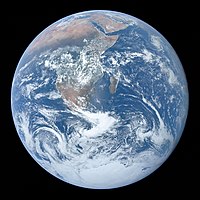
Photo from wikipedia
Abstract Species are disappearing worldwide with increasing rates through the time, especially in the tropics. The human-induced impacts have a pivotal role in the discussion about the cause of these… Click to show full abstract
Abstract Species are disappearing worldwide with increasing rates through the time, especially in the tropics. The human-induced impacts have a pivotal role in the discussion about the cause of these extinctions events. Although researchers are nearly unanimous about the current biodiversity crisis, there is still a debate about how these human-induced impacts affect biodiversity across different geographical scales. While our perception about landscape modification promoted by deforestation occurs at local scales, we treat the increase of greenhouse gas emissions and its consequences in a global perspective. This diffuse view about different processes but potential assembling properties illustrates the importance of combining small and broad-scales to improve our conservation actions and decelerate extinction events. Here, we propose an integrated framework (Ecoland) combining landscape ecology and macroecology for niche modelling applications, aiming to disentangle the effects of human-induced impacts on biodiversity and guide conservation tasks at multiple scales. We demonstrated the EcoLand application using a dataset of fruit-feeding butterfly species occurrence from the Atlantic Forest. Our findings highlight the impact of the land-use modification on the number of butterfly species. Finally, we discuss the method implications, its limitations and perspectives, and how it the Ecoland can help us to design conservation strategies aiming at the maintenance of biodiversity and its related policy practices.
Journal Title: Perspectives in Ecology and Conservation
Year Published: 2021
Link to full text (if available)
Share on Social Media: Sign Up to like & get
recommendations!